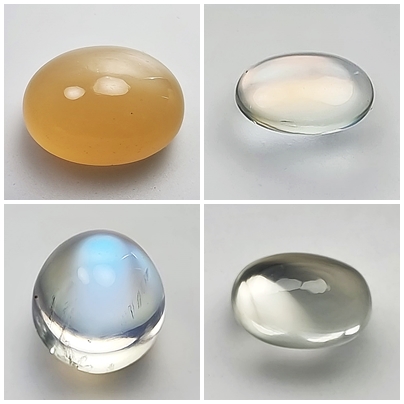Moonstone: Gemstone Information
The Enchanting Moonstone: A Gem of Mystery and Elegance
Moonstone, with its ethereal glow and captivating aura, has long been cherished as a gem of mystery and elegance. Admired for its unique optical properties and mystical allure, moonstone holds a special place in the world of gemstones. Let’s delve into the fascinating world of moonstone, exploring its origins, properties, and the benefits it offers to those who embrace its enchanting beauty.
Origins and History:
Moonstone is a variety of the mineral feldspar, known for its mesmerizing adularescence—a phenomenon where light scatters within the gem, creating a soft, glowing effect reminiscent of the moon’s luminosity. Historically, moonstone has been revered across cultures for its mystical significance and believed metaphysical properties.
Ancient Romans and Greeks associated moonstone with their lunar deities, believing it to be formed from solidified moonbeams. In Hindu mythology, it was believed to be made from moonlight, and thus, held sacred powers. Moonstone has also been prized in traditional Asian cultures, particularly in India, where it is considered a sacred and powerful gemstone.
Properties and Characteristics:
Moonstone’s allure lies in its unique optical properties. It belongs to the orthoclase and albite mineral groups, displaying a remarkable play of light known as adularescence. This optical effect gives moonstone its characteristic glow, often appearing as a soft blue or white light dancing across its surface.
Moonstone typically exhibits a translucent to opaque appearance, with colors ranging from colorless to gray, peach, pink, green, and blue. The most desirable moonstones possess a blue sheen, reminiscent of moonlight on water.
In terms of hardness, moonstone ranks around 6 to 6.5 on the Mohs scale, making it relatively durable for jewelry purposes. However, it still requires gentle care to preserve its beauty over time.
Benefits and Symbolism:
Beyond its aesthetic appeal, moonstone is associated with various benefits and symbolism:
Emotional Balance: Moonstone is believed to promote emotional balance and harmony, helping to calm the mind and soothe turbulent emotions. It is often used as a talisman for emotional healing and stability.
Intuition and Insight: Known as the “stone of new beginnings,” moonstone is said to enhance intuition and psychic abilities, guiding individuals on their spiritual journey and fostering a deeper connection to the subconscious mind.
Feminine Energy: Moonstone is often associated with feminine energy and the divine feminine archetype. It is believed to evoke qualities of nurturing, compassion, and intuition, making it a popular choice for women’s jewelry.
Protection and Luck: In various cultures, moonstone is considered a talisman for protection and good fortune. It is believed to ward off negative energies and bring luck and prosperity to its wearer.
Creativity and Inspiration: Moonstone’s mystical aura is said to inspire creativity and imagination. It is often used by artists, writers, and musicians as a muse to unlock their creative potential.
Uses and Care:
Moonstone’s enchanting beauty makes it a popular choice for jewelry, including rings, earrings, necklaces, and bracelets. Its subtle glow adds a touch of elegance to any outfit, making it suitable for both casual and formal occasions.
To care for moonstone jewelry, it’s essential to handle it with care and avoid exposing it to harsh chemicals or extreme temperatures. Clean it gently using a soft cloth and mild soap, avoiding abrasive cleaners that may damage its delicate surface.
In conclusion, moonstone continues to captivate hearts with its mystical allure and timeless elegance. Whether admired for its aesthetic beauty or cherished for its metaphysical properties, moonstone remains a gemstone of enduring fascination, weaving a tapestry of enchantment wherever it goes.
For those seeking a gemstone that embodies the magic of the moon and the mysteries of the universe, moonstone shines as a radiant beacon of light and wonder.





